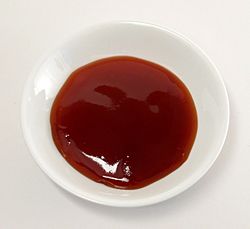Hagebuttenmark facts for kids
 |
|
| Type | Spread |
|---|---|
| Main ingredients | Rose hips, sugar, sometimes red wine |
Hagebuttenmark is a traditional fruit spread made from rose hips, sugar, and sometimes red wine. It has different names depending on where you are! For example, people in some parts of Germany call it Hägenmark or Hiffenmark. In Switzerland, it's known as Buttenmost.
In the past, Hagebuttenmark was a very important food. Rose hips are packed with vitamin C, and you can pick them even in winter. This made the spread a great way to get important vitamins when other fresh foods were scarce. Today, Hagebuttenmark is often used as a spread on bread. You can also use it to sweeten drinks or as a tasty extra in desserts and pastries. For instance, in a region called Franconia, it's used as the filling for a type of doughnut called Krapfen.
How is Hagebuttenmark Made?
There are two main ways to make Hagebuttenmark: a traditional method and a more common method used by larger companies.
Traditional Method
The traditional Swabian method is quite special. First, the rose hips are cut open and left to soften for about five days at a cool temperature (around 12 degrees Celsius). After they are soft, they are pressed through a sieve without being cooked. This creates a smooth pulp.
This pulp is then gently heated with sugar to a temperature between 65 and 75 degrees Celsius. Sometimes, it's even mixed with honey without heating! To add more flavor, people might mix in wine, orange juice, or apple juice. This traditional way of making Hagebuttenmark helps keep a lot of the vitamin C in the finished spread.
A village called Auendorf, which is part of Bad Ditzenbach, is famous for this traditional method. It's even known as "Hägenmarkdorf," which means "Hägenmark village" in German! This village is the only one in Germany that has rose hips on its coat of arms.
Common Method
The method often used by big companies starts by removing the seeds from the rose hips. Then, these seeds are cooked with a little water or wine. The liquid from this is drained and mixed with the rose hip pulp. This mixture is left to brew for a few hours or even a few days.
Next, the pulp is cooked and puréed until smooth. It's then mixed with sugar, usually in equal amounts. This mixture is cooked again and poured hot into jars. This method helps the Hagebuttenmark last a very long time on the shelf. However, because vitamin C is sensitive to heat, most of it is lost during this cooking process.

